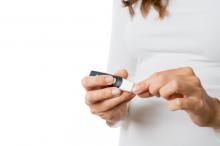Blood Sugar Testing for People with PCOS and Chronic Stress

We take blood sugar pretty seriously ‘round these parts, for a host of reasons.
Blood sugar instability (dysglycemia) wreaks havoc on our adrenal glands – those tiny endocrine powerhouses whose overproduction of the stress hormones adrenaline and cortisol can greatly impact thyroid function. Hypoglycemia, or low blood sugar, can trigger a cascade of hard-to-manage symptoms, including mood imbalance, energy dips, head fog, and insatiable cravings. And while our adrenals are pumping stress hormones, the hypothalamus gets a little distracted from its job spurring thyroid hormone production vis a vis disruption to the hypothalamic, pituitary, thyroid (HPT) axis. Next thing you know, your thyroid has become sluggish.
So, yes, we spend a lot of time coaching our thyroid and adrenal clients on how to maintain stable blood sugar and avoid hypoglycemic episodes. (Jill calls these hair-raising episodes “the pit.”)
[You can find Jill’s newly updated (2022) ebook here: Balance Your Blood Sugar, Balance Your Life]
Although low blood sugar can cause short-term concerns for many of us, consistently high blood sugar poses serious, long-term risks. Anyone with polycystic ovary syndrome (PCOS), or people who are in prolonged periods of extreme stress, are at risk for elevated blood sugar, and would be well-served to monitor trends in blood sugar to nip any potential increases in the bud.
PCOS is a condition characterized by hormonal imbalance. One such hormone impacted in women with PCOS is insulin, produced by the pancreas to allow our cells to access the energy available from our food. In essence, insulin regulates the amount of sugar in our blood.
Women with PCOS are at a particular risk for insulin resistance (meaning that the body’s cells no longer respond as effectively to insulin) and type 2 diabetes. Those conditions, in turn, lead to higher risks of other complications, including cardiovascular disease and metabolic syndrome.
But women with PCOS aren’t the only ones who should be concerned about elevated blood sugar. Anyone who has experienced chronic high-stress may suffer some ill-effects of excess cortisol. As Chris Kresser explains, “[C]hronic stress can not only increase absolute cortisol levels, but more importantly it disrupts the natural cortisol rhythm. And it’s this broken cortisol rhythm that wreaks so much havoc on your body. Among other effects, it:
- raises your blood sugar
- makes it harder for glucose to get into your cells
- makes you hungry and crave sugar
- reduces your ability to burn fat
- suppresses your HPA-axis, which causes hormonal imbalances
- reduces your DHEA, testosterone, growth hormone and TSH levels [and]
- makes your cells less sensitive to insulin.”
Monitoring blood sugar levels may allow us to catch subtle increases before complications ensue.
Fortunately, testing your blood sugar, or blood glucose, is quick and easy, and doesn’t require a trip to the doctor. All you need is a widely-available glucometer and the corresponding test strips. (Amazon sells several reputable brands, including Bayer and FreeStyle.)
Blood sugar levels vary throughout the day and are impacted by a variety of factors, including menstrual cycles, illness, time since your last meal, stress, and physical activity. Thus, the most accurate measurement of blood sugar, known as “fasting glucose,” is taken first thing in the morning, at least eight hours after eating or drinking, and before any exercise.
Ideal fasting blood glucose levels are not generally higher than 85 mg/dL. Someone is considered “pre-diabetic” if her level is higher than 100 mg/dL, and diabetic if it’s higher than 125 mg/dL. An increasing number of functional medicine practitioners advise folks to stay as close to 85 mg/dL as possible, and to take steps to reduce blood sugar levels if measurements are consistently higher than 85-90 mg/dL.
To test your blood sugar:
- Follow the manufacturer’s instructions for your glucometer. Test first thing in the morning, before you eat or drink anything (other than water).
- Keep a record of the result.
- Test again for the next two consecutive mornings, and calculate the average.
- Take three daily consecutive tests monthly (at approximately the same time if your cycle, if you menstruate).
Monitor for consistent increases in your monthly averages. If your results are on the rise, and/or if any monthly average is higher than 100 mg/dL, consult your physician. Even the most accurate glucometers have a margin of error of 10-20%, so do not become too concerned about any individual result. Averages and trends are most important.
Your doctor or healthcare provider can run additional tests, including a hemoglobin A1c and a fasting insulin, to further evaluate insulin sensitivity. But testing your own blood sugar periodically at home will help ensure that you know when it’s time to consult professionals.
Add comment